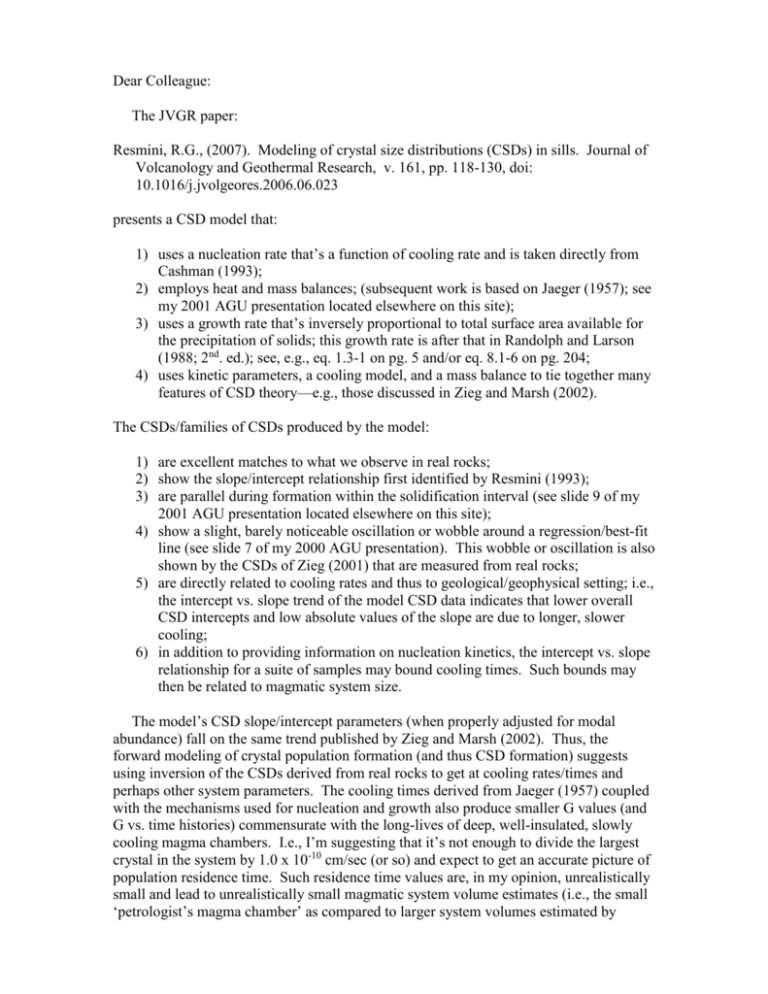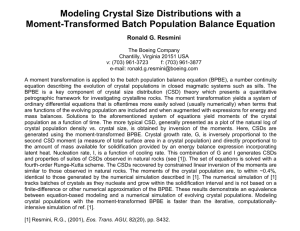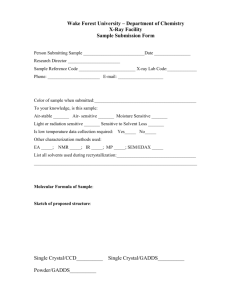Note_to_Colleagues
advertisement

Dear Colleague: The JVGR paper: Resmini, R.G., (2007). Modeling of crystal size distributions (CSDs) in sills. Journal of Volcanology and Geothermal Research, v. 161, pp. 118-130, doi: 10.1016/j.jvolgeores.2006.06.023 presents a CSD model that: 1) uses a nucleation rate that’s a function of cooling rate and is taken directly from Cashman (1993); 2) employs heat and mass balances; (subsequent work is based on Jaeger (1957); see my 2001 AGU presentation located elsewhere on this site); 3) uses a growth rate that’s inversely proportional to total surface area available for the precipitation of solids; this growth rate is after that in Randolph and Larson (1988; 2nd. ed.); see, e.g., eq. 1.3-1 on pg. 5 and/or eq. 8.1-6 on pg. 204; 4) uses kinetic parameters, a cooling model, and a mass balance to tie together many features of CSD theory—e.g., those discussed in Zieg and Marsh (2002). The CSDs/families of CSDs produced by the model: 1) are excellent matches to what we observe in real rocks; 2) show the slope/intercept relationship first identified by Resmini (1993); 3) are parallel during formation within the solidification interval (see slide 9 of my 2001 AGU presentation located elsewhere on this site); 4) show a slight, barely noticeable oscillation or wobble around a regression/best-fit line (see slide 7 of my 2000 AGU presentation). This wobble or oscillation is also shown by the CSDs of Zieg (2001) that are measured from real rocks; 5) are directly related to cooling rates and thus to geological/geophysical setting; i.e., the intercept vs. slope trend of the model CSD data indicates that lower overall CSD intercepts and low absolute values of the slope are due to longer, slower cooling; 6) in addition to providing information on nucleation kinetics, the intercept vs. slope relationship for a suite of samples may bound cooling times. Such bounds may then be related to magmatic system size. The model’s CSD slope/intercept parameters (when properly adjusted for modal abundance) fall on the same trend published by Zieg and Marsh (2002). Thus, the forward modeling of crystal population formation (and thus CSD formation) suggests using inversion of the CSDs derived from real rocks to get at cooling rates/times and perhaps other system parameters. The cooling times derived from Jaeger (1957) coupled with the mechanisms used for nucleation and growth also produce smaller G values (and G vs. time histories) commensurate with the long-lives of deep, well-insulated, slowly cooling magma chambers. I.e., I’m suggesting that it’s not enough to divide the largest crystal in the system by 1.0 x 10-10 cm/sec (or so) and expect to get an accurate picture of population residence time. Such residence time values are, in my opinion, unrealistically small and lead to unrealistically small magmatic system volume estimates (i.e., the small ‘petrologist’s magma chamber’ as compared to larger system volumes estimated by geophysicists). I’m also suggesting that it’s not enough to simply use, e.g., 1.0 x 10-10 cm/sec (or so) with CSD slope to get realistic values. Using cooling models to estimate and get G from CSD slope also has pitfalls. With this model, it is also possible to generate CSDs with the kink at small crystal size: model a population forming as a batch and get the bulk of the CSD. Then ‘move’ or ‘erupt’ the magma through a more rapidly cooling regime (simulating travel through a conduit with progressively cooler temperatures) and continue nucleation and growth with the same mechanisms already discussed. I have not yet done the calculations to invert cooling histories in a conduit or eruption velocities/fluxes. I believe, however, that the model will facilitate these calculations and inversions. Lastly, and as discussed in detail in my 2000 AGU presentation, though I do NOT use a growth rate model based on cooling rate as provided in Cashman (1993), I can almost exactly recover the G vs. dT/dt (i.e., cooling rate) relationship for a family of CSDs from a model sill. I view this point as a strong argument for the veracity of the model and its mix of nucleation and growth mechanisms. Citations: Cashman, K.V., (1993). Relationship between plagioclase crystallization and cooling rate in basaltic melts. Contrib. Mineral. Petrol., v. 113, pp. 126-142. Jaeger, J.C., (1957). The temperature in the neighborhood of a cooling intrusive sheet. Am. J. Sci., v. 255, pp. 306-318. Randolph, A.D., and Larson, M.A., (1988). Theory of Particulate Processes, 2nd ed. Academic Press, Inc., San Diego, 369p. Resmini, R.G., 2002. Modeling crystal size distributions with a moment-transformed batch population balance equation. EOS, Trans., A.G.U.; v. 83, no. 19, p. S380. Resmini, R.G., 2001. The crystal size distribution (CSD) intercept vs. slope relationship: a numerical simulation. EOS, Trans., A.G.U.; v. 82, no. 20, p. S432. Resmini, R.G., 2000. Numerical simulation of crystal size distributions (CSDs) in sills. EOS, Trans., A.G.U., v. 81, no. 19, p. S435. Resmini, R.G., (1993). Dynamics of magma within the crust: A study using crystal size distributions. Ph.D. Dissertation, Johns Hopkins University, 329 pp. Zieg, M.J., and Marsh, B.D., (2002). Crystal size distributions and scaling laws in the quantification of igneous textures. J. Petrol., v. 43, no. 1, pp. 85-101. Zieg, M.J., (2001). Cooling and crystallization of the Sudbury Igneous Complex. Ph.D. dissertation, Johns Hopkins University, Baltimore, MD.





